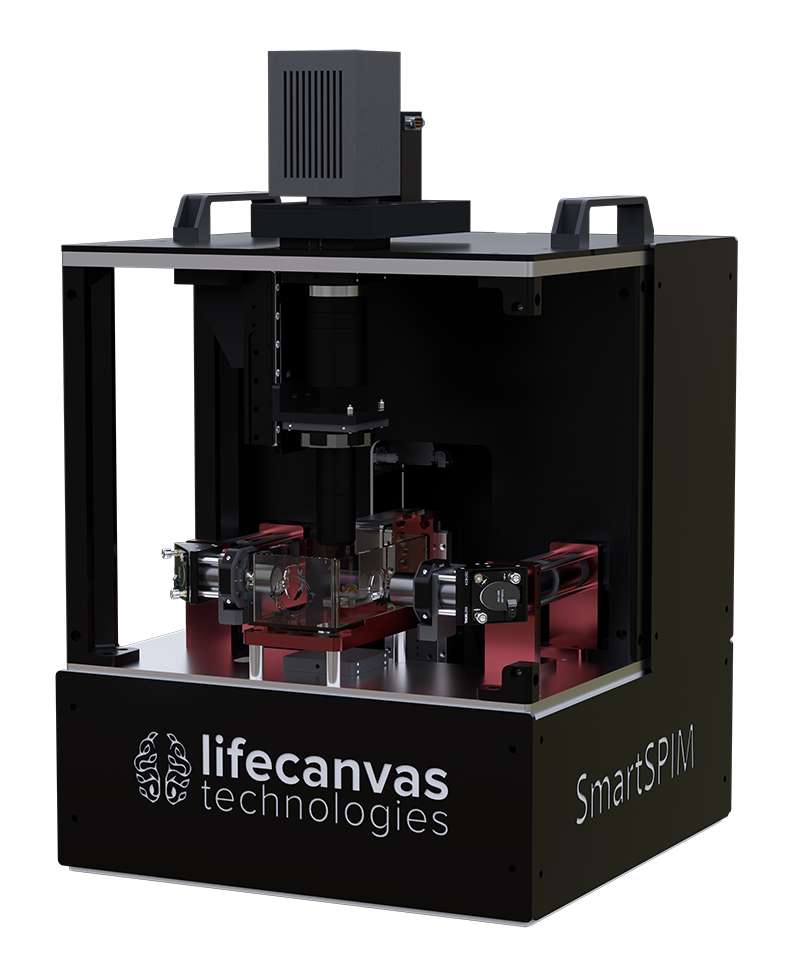Dr. Sam Centanni uses the LifeCanvas pipeline to investigate the neurobiological overlap between stress and predisposition to alcohol abuse, as well as long-term effects of alcohol on the brain.
With uniform axial resolution across the whole sample, rapid volumetric imaging, and a custom imaging chamber, the SmartSPIM light sheet microscope provides the accuracy, speed, and flexibility you need to generate the highest quality data. Unlike many light sheet microscopes, SmartSPIM makes no compromises on resolution or acquisition speed.

The SmartSPIM light sheet microscope leverages patented axial sweeping technology (Dean et al. 2015): illumination optics scan the beam while synchronized to the camera’s rolling shutter detection, providing homogeneous axial point spread functions (PSFz) across the entire field of view (FOV).
Left: The sample imaged without axial sweeping displays high axial resolution only at the center of the FOV, while the sample imaged with sweeping shows uniform axial resolution across the FOV.
Microglia (IBA-1, 647 nm) in cortex of a 7-month-old wild-type C57BL/6 male mouse from Taconic Biosciences, model #B6, 3.6X objective.
Custom-designed imaging chamber and sample holders can accommodate a variety of tissue sizes, from organoids to rat brains, and even entire juvenile mice! With no points of contact between tissue and mounting hardware, the user can mount many sample types and sizes in different orientations.
Tunable imaging parameters allow for high speed volumetric imaging while maintaining quality resolution. 20 fps acquisition allows imaging of a mouse brain hemisphere or comparably sized intact sample in <30 minutes (at 1.8 µm x 1.8 µm x 4 µm voxel size).
Streamlined for efficient data collection, SmartSPIM’s acquisition software has real-time tile correction and is simple to operate, making imaging large samples a breeze.
Dr. Sam Centanni uses the LifeCanvas pipeline to investigate the neurobiological overlap between stress and predisposition to alcohol abuse, as well as long-term effects of alcohol on the brain.
Dr. Mike Taormina uses SmartSPIM light sheet microscopy to rapidly image whole mouse brains, streamlining workflows at the Allen Institute.
Dr. Kim's lab at Penn State uses the SmartSPIM light sheet microscope to map and create 3D atlases of the developing mouse brain.
Dr. Ye's lab at the Scripps Research Institute uses SmartSPIM to illuminate interactions between the central and peripheral nervous systems.
Prepare samples with tools for preservation, clearing, labeling, & sectioning.
Acquire spatially informative images with innovative microscopy techniques.
Generate publication-quality data with robust analysis tools.
Joselyn S. Soto, Chiranjivi Neupane, Muskan Kaur, Vijaya Pandey, James A. Wohlschlegel, Baljit S. Khakh
Christina A. von Roemeling, Jeet A. Patel, Savannah L. Carpenter, Oleg Yegorov, Changlin Yang, Alisha Bhatia, Bently P. Doonan, Rylynn Russell, Vrunda S. Trivedi, Kelena Klippel, Daniel H. Ryu, Adam Grippin, Hunter S. Futch, Yong Ran, Lan B. Hoang-Minh, Frances L. Weidert, Todd E. Golde & Duane A. Mitchell
Pantelis Antonoudiou, Bradly T. Stone, Phillip L.W. Colmers, Aidan Evans-Strong, Eric Teboul, Najah L. Walton, Grant L. Weiss, Jamie Maguire.
Dr. Montero Llopis shares her insights on the MicRoN Core’s vision, its adoption of LifeCanvas technologies, and how our values...
Dr. Tanya Daigle used LifeCanvas' Services to acquire 3D images of spinal motor neurons illuminated by enhancer AAV.
Dr. Sam Centanni uses the LifeCanvas pipeline to investigate the neurobiological overlap between stress and predisposition to alcohol abuse, as...
Dr. Mike Taormina uses SmartSPIM light sheet microscopy to rapidly image whole mouse brains, streamlining workflows at the Allen Institute.
For technical support reach out to our dedicated customer support team at support@lifecanvastech.com.